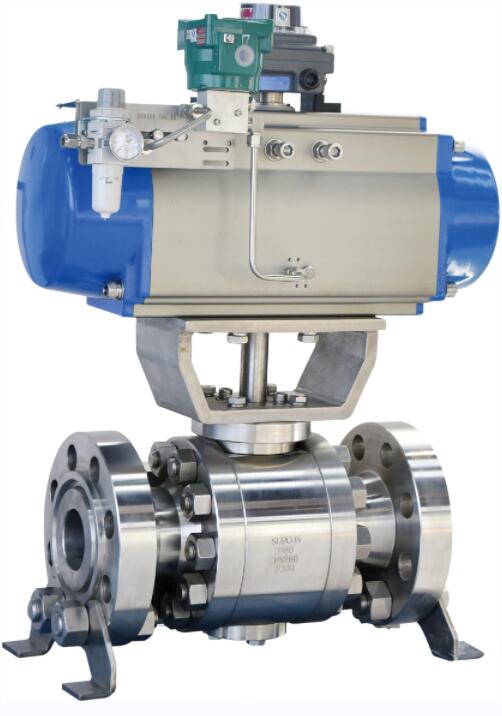A pneumatic globe valve is a specialized type of control valve designed to regulate the flow of fluids within a system by utilizing a combination of a pneumatic globe valve design and a pneumatic actuation system.
The primary function of this valve is to precisely manage the flow rate, pressure, or level of fluids in a controlled manner. The inclusion of a pneumatic actuator allows for remote and automated operation, enhancing the valve's responsiveness and adaptability to changing process conditions.
Precise Control: The globe valve design offers excellent flow control accuracy, making it suitable for processes that require tight regulation of flow rates and pressures.
Automation: The pneumatic actuator enables the valve to be remotely controlled, integrated into automated systems, and adjusted based on real-time input signals or process conditions.
Process Stability: By responding quickly to control signals, these valves help maintain consistent process variables, contributing to stable and efficient operation.
PID Control Loops: They are commonly integrated into proportional-integral-derivative (PID) control loops to achieve refined and continuous control over complex processes.
Safety: The combination of precise control and automated operation makes these valves valuable for maintaining safe process conditions and responding to emergency shutdown signals.
Process Optimization: Industries such as petrochemicals, oil and gas, and power generation benefit from these valves in optimizing processes for efficiency, quality, and reliability.
Valve Body: The valve body houses the flow passage and the plug or disc that regulates the flow. The globe valve design allows for smooth throttling of fluid.
Pneumatic Actuator: The actuator is powered by compressed air or gas and controls the valve's position. By adjusting the air pressure, the actuator opens, closes, or positions the valve plug to achieve the desired flow rate.
Positioner: A positioner is often used alongside the actuator to precisely control the valve's position based on the input signal from the control system.
Controller: The controller sends control signals to the positioner, dictating the desired valve position based on process requirements.
Precise Flow Control: The globe valve design, coupled with the pneumatic actuator, enables accurate and finely tuned control over fluid flow rates, pressures, and levels. This precision is crucial for maintaining desired process conditions and optimizing system performance.
Automation: The integration of a pneumatic actuator allows for remote and automated control of the valve. This automation enhances operational efficiency, reduces the need for constant manual adjustments, and enables seamless integration into complex control systems.
Responsive Operation: Pneumatic actuators respond quickly to control signals, facilitating rapid adjustments to changing process conditions. This responsiveness ensures that the valve can promptly adapt to variations in flow demands or disturbances in the system.
PID Control Integration: These pneumatic globe valve can be easily integrated into proportional-integral-derivative (PID) control loops, enabling dynamic and continuous adjustments based on feedback from sensors or process measurements. This results in efficient and stable process control.
Safety Enhancement: The combination of precise control and automated operation contributes to improved safety. The valve can be programmed to respond to emergency shutdown signals, preventing hazardous situations by rapidly closing off or adjusting flow as needed.
Consistent Process Variables: With the ability to maintain accurate control over flow rates and pressures, these valves ensure that process variables remain consistent, leading to stable and reliable operations.
Remote Monitoring: The remote control capability provided by the pneumatic actuator allows for monitoring and adjustments from a distance, reducing the need for on-site personnel and enhancing operational flexibility.
Energy Efficiency: By accurately controlling flow rates and minimizing pressure losses, these valves contribute to energy efficiency and reduce wastage, especially in processes where maintaining specific conditions is crucial.
Process Optimization: Industries requiring precise control over fluid flow, such as chemical, petrochemical, and power generation, can optimize their processes for improved efficiency, quality, and product output.
Reduced Maintenance: The automation provided by pneumatic actuators can reduce wear and tear on valves, resulting in extended service life and lower maintenance requirements.
Pinch valves use a flexible rubber or plastic tube that is pinched closed to regulate fluid flow.
View MoreContact Us
Related Information
China Gate ValveHigh Pressure Ball Valves ManufacturersStainless Steel Globe ValvePFA Lined Ball ValvesHigh Pressure Single Seat ValveGlobe Valve For Flow ControlStainless Steel Single Seat ValveIndustrial Globe Valves SupplierPneumatic Globe Control ValveGlobe Control Valve With Pneumatic ActuatorCarbon Steel ValvesCarbon Steel Butterfly ValveChina ValveLined Butterfly ValvesPneumatic Single Seat ValveOil And Gas Valves ManufacturerBellow Seal Globe ValveBall Valve Manufacturer in ChinaLined Ball ValveTriple Offset Butterfly Valve ManufacturerControl Valve ChinaGlobe Control Valve ManufacturerChina Butterfly ValveHeadquarter Add.: SUPCON Park, No.309 Liuhe Road, Binjiang District, Hangzhou, 310053, China.
Tel.: +86 571 8111 9774
Fax: +86 571 8111 9737
E-mail: [email protected]

